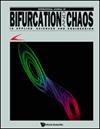Learning Topological Horseshoe via Deep Neural Networks
IF 2.3
4区 数学
Q2 MATHEMATICS, INTERDISCIPLINARY APPLICATIONS
引用次数: 0
Abstract
Deep Neural Networks (DNNs) have been successfully applied to investigations of numerical dynamics of finite-dimensional nonlinear systems such as ODEs instead of finding numerical solutions to ODEs via the traditional Runge–Kutta method and its variants. To show the advantages of DNNs, in this paper, we demonstrate that the DNNs are more efficient in finding topological horseshoes in chaotic dynamical systems.
通过深度神经网络学习拓扑马蹄铁
深度神经网络(DNN)已成功应用于有限维非线性系统(如 ODEs)的数值动力学研究,而不是通过传统的 Runge-Kutta 方法及其变体来寻找 ODEs 的数值解。为了展示 DNNs 的优势,我们在本文中证明 DNNs 在寻找混沌动力学系统中的拓扑马蹄形时更为有效。
本文章由计算机程序翻译,如有差异,请以英文原文为准。
求助全文
约1分钟内获得全文
求助全文
来源期刊
CiteScore
4.10
自引率
13.60%
发文量
237
审稿时长
2-4 weeks
期刊介绍:
The International Journal of Bifurcation and Chaos is widely regarded as a leading journal in the exciting fields of chaos theory and nonlinear science. Represented by an international editorial board comprising top researchers from a wide variety of disciplines, it is setting high standards in scientific and production quality. The journal has been reputedly acclaimed by the scientific community around the world, and has featured many important papers by leading researchers from various areas of applied sciences and engineering.
The discipline of chaos theory has created a universal paradigm, a scientific parlance, and a mathematical tool for grappling with complex dynamical phenomena. In every field of applied sciences (astronomy, atmospheric sciences, biology, chemistry, economics, geophysics, life and medical sciences, physics, social sciences, ecology, etc.) and engineering (aerospace, chemical, electronic, civil, computer, information, mechanical, software, telecommunication, etc.), the local and global manifestations of chaos and bifurcation have burst forth in an unprecedented universality, linking scientists heretofore unfamiliar with one another''s fields, and offering an opportunity to reshape our grasp of reality.

 求助内容:
求助内容: 应助结果提醒方式:
应助结果提醒方式:


